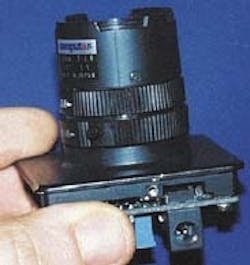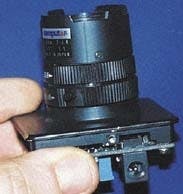Novel cameras debut at IPOT
In Europe, the success of VISION 2000 in Stuttgart last October has been followed by the equally successful Image Processing and Optical Technology (IPOT) show held in Birmingham, England, last February. Highlighting the show were several innovative cameras from European vendors. Neuricam (Trento, Italy) and Lord Ingenierie (Corbreuse, France) both demonstrated intelligent cameras.
At the Neuricam booth, Alvise Sartori, company founder, unveiled the pICAM twin-board camera module. It measures 53 x 53 x 40 mm and incorporates a 256 x 256-pixel, 25-frame/s, progressive-scan CMOS sensor—the ADSP-2181 DSP from Analog Devices (Norwood, MA)—and an LVDS serial interface. Available as either an open frame version or a complete camera, the module comes with a standard C library that helps programmers develop object recognition, optical character recognition, and security applications.
In the design of its smart cameras, Lord Ingenierie chose to couple a 2k x 1 CCD line-scan CCD with a 68331 microcontroller from Motorola (Austin, TX). The result—the CIL 2048 linescan camera—is an intelligent 800 x 600 x 8-bit camera that can be used in stand-alone mode. To program the device, a video monitor and a mouse point and focus the camera on the object and adjust integration time and detection parameters. Once the system is configured, the results of the image inspection are transmitted via the camera's serial links and serial bus or to activate binary signals.
Neuricam's pICAM intelligent twin-board camera module incorporates a 256 x 256, 25-frame/s, progressive-scan CMOS sensor and an LVDS serial interface. The camera has a C library that allows programmers to develop applications for object recognition, optical character recognition, and security applications.
VDS Vosskuhler (Osnabruck, Germany) also chose a CMOS imager for the design of its HCC-1000, 500-frame/s, 1024 x 1024 x 8-bit camera. Shown in the booth of VDS Vosskuhler's UK distributor, Alrad Imaging (Newbury, Berkshire, England), the camera incorporates a 512-Mbyte internal memory buffer and an 8-bit RS-644 LVDS output. According to Ian Alderton, managing director of Alrad, VDS Vosskuhler is currently evaluating whether to incorporate the Camera Link standard into the camera.
Targeting high resolution, Atmel Grenoble (Grenoble, Switzerland), formerly Thomson Semiconducteurs Spécifiques (TCS), showed its Camelia family of digital imaging systems. These include a 2300 x 3500 CCD camera head, custom PCI frame grabber, and associated software. The Camelia 8M and Color 8M deliver 12-bit monochrome and 12-bit/color data, respectively, to a host PC memory at 2.5 frames/s. Both camera systems can be controlled through an RS-232 serial port and feature either continuous grab or asynchronous operation.

